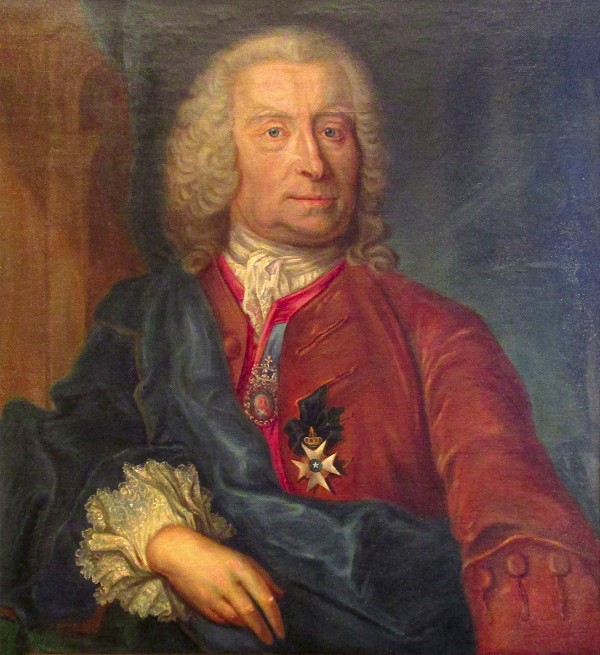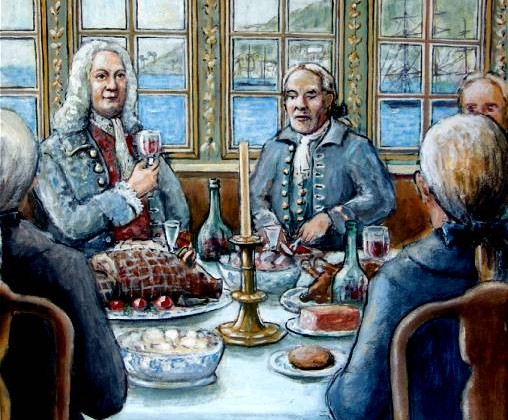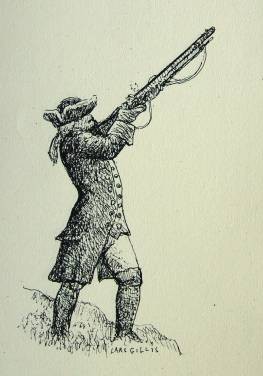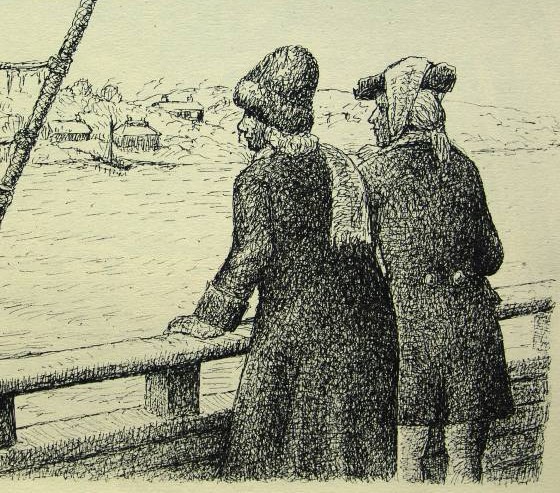The clothes of crew and officer
During the excavation no traces of any of the clothes belonging to the crew or the officials was found except some minute fibers that could equally well or as a matter of fact, more likely, originated from the sails or general rigging.
It is however interesting to try to figure out how people on board an early to mid 18th century East Indiaman was dressed. To figure this out I have drawn from various online resources regarding how European men of various occupations was dressed. To out help we also have pottery models, painted enamel decorations from export porcelain and a variety of portraits of the more successful officials. However, we can not know if they choose to dress the same on land as on board. Very likely there would have been some differences.

Colin Campbell founder and first supercargo of the Swedish East India Company
Supracargoes
The Supracargoes were the owners representatives on board and often participated with a large financial stake in the voyages, being major shareholders or lenders to the individual cargoes as well as being permitted to take on board a considerable amount of merchandises on their own accounts. They had the highest rank on board and was giving the Captain orders on destinations. During the first half of the 18th century the Supracargoes were of Scottish descent and most likely dressed as most European noblemen and successful merchants.

The seating at the first table was settled in the ships regulations ahead of departure.
Officials
The captain and other officers on board was in general taken from the navy, and it would be likely that they on board was wearing more or less the outfit they would normally wear in active duty in the navy.

The crew
The crew was mostly farm hands that only gradually became seasoned East India travelers. We must assume that their clothes must have been what they wore when they signed up as a crew plus what other sailors would have helped them to acquire, plus eventually any fancy stuff they would pick up during the voyages, hat would set them apart from the common sailors once they sat foot on land after homecoming. Clothes also varied with the seasons. From various diaries such as Wallenberg, Min son på Galejan, we have been given some descriptions of the crews clothes when still at anchor in the freezing winter weather at Rivö Fjord before departure.

Clothes also varied with the seasons, from ice cold winter at departure to the tropical weather of South East Asia and southern China.
Various 18th century men's clothes and accessories
Banyan
A gentleman's banyan was a loose, informal robe to be worn instead of a coat. Influenced by Oriental fashion, these popular robes were also called Indian gowns, nightgowns, or wrappers. Cut either in a loose T-shape or as a long simplified coat, they were acceptable wear for home or informal business. Made most often of patterned materials, these useful garments could vary from light and cool to quilted and warm. (See also Negligé Cap)
Breeches
From the late 16th century until the early 19th century, most men wore breeches as their lower body garment. Through the centuries breeches were seen in many forms and lengths. In the early 18th century breeches were barely seen beneath long waistcoats and coats. By the mid-18th century they were more noticeable beneath shorter waistcoats and open coats, and so the cut of breeches became tighter and revealed the shape of the leg. Worn by all levels of society, breeches were made in a great variety of silks, cottons, linens, wools, knits, and leathers. (See also Trousers)
Coat
A coat was the uppermost layer of the 18th century man's suit, worn over waistcoat and breeches. Both the cut and the title of the fashionable coat saw several evolutions through the course of the century. In the late 17th and early 18th centuries a coat was a relatively straight loose garment, with the slight fullness in the knee-length skirts falling into folds over the backside of the hips. In the 1720s and 1730s the skirts of the fashionable coat grew in volume and were set into regular pleats. In the 1730s an alternative to the weighty full skirted coat was developed. This new fashioned coat, with narrow skirts set in pleats and other defining features, including a collar, was termed a Frock. Through the middle decades of the century both the coat and the frock were worn, coats being for fashionable full dress, frocks for fashionable undress. By the 1770s the distinctions in purpose and terminology were becoming blurred. None but the most conservative older man would be seen in a full-skirted coat. The frock had entered into fashionable full dress, and was by many simply referred to as a coat. In the closing decade of the 18th century and into the next, the frock dominated fashionable dress and language. (See also Suit)
Cloak
The cloak has been the most enduring of outer garments throughout the history of fashion. In the 18th century a man's cloak was made with a collar at the neck, a cape over the shoulders, and hung to the knee or below. The most usual form was circular. Cloaks were made of dense well-fulled wools, often dyed scarlet. Other choices in fabric included worsteds, camlets, and occasionally plaids. Cloaks were also known a "roquelaires" or "rockets." It was in the 18th century that a rival to the dominance of the cloak appeared in the form of the great coat. (See also Great Coat)
Cravat
Cravat The 18th-century man almost always wore some sort of neck cloth, whether fashionably dressed or at labor.The cravat was one of many forms of neckwear. It was a narrow length of white linen that could be adorned on its ends with lace, fringe, or knots. It was worn wrapped about the throat and loosely tied in front. The cravat was first seen in fashionable dress in the mid-17th century. It was derived from the "crabate" worn by Croatian soldiers serving with the French Army (ca. 1645-1650). By the mid 18th century it was worn in informal attire. (See also Neck Handkerchief and Stock)
Great Coat or Cloak
Many men of the 18th century chose great coats as their protective outer garment in foul weather. Most often made of heavy fulled woolens, it served well to keep one warm and dry. Some men are known to have had accompanying waistcoats and leggings made in the same heavy wools. The great coat generally had a collar, a cape over the shoulders, deep cuffs, and was worn to knee length or longer. Occasionally, great coats were made in alternative fabrics of lighter weights, particularly oiled silk and linen.
Hat
Towards the end of the 17th century the vast wigs then worn by some men made it impractical for them to wear the fashionable broad-brimmed hat unless necessary. Custom dictated, however, that hats should then be carried beneath the arm. Rapidly, the hat began to be folded to make it easier to carry. In the 18th century this habit and changing fashions led to many sorts of folded or cocked hats - cocked on one, two, or three sides. It was the hat with three sides cocked that dominated fashion and was seen in innumerable variations of adornment and proportion. While beaver felt was the preferred material others, including wool and camel's down, were available.
Leggings or Spatterdashes (spats)
Since a man's breeches of the 18th century came to just beneath the knee, a covering for the lower leg was useful for warmth and protection. Leggings fully covered the lower leg from a few inches above the knee extending to cover the top of the foot. Spatterdashes covered the leg from the mid-shin to the top of the foot. Made of stout woolen or linen cloth or of leather, leggings and spatterdashes were worn by the sporting gentleman, laboring man, and the military.
Monmoth or Monmouth Cap
In the 17th and 18th centuries small knitted woolen caps worn by the laboring sort, sailors, and western slaves were often referred to as "Monmouth Caps." The name is derived from one of England's great port cities and its particular associations with seafaring. Knitting of caps and stockings was a common pastime for sailors, they sold their wares in the dock streets for additional income.
Neck Handkerchief
The most informal sort of neckwear generally worn by sporting gentlemen, working tradesmen, and laboring western slaves. It commonly was a square folded and tied around the neck. They were usually made of linen, cotton, or silk, and could be in white, plain colors, woven checks and stripes, or printed patterns. (See also Cravat and Stock)
Negligé Cap
The negligé cap was a small informal cap often, though not always, worn to accompany a banyan. For some men it served to cover a shaved head when the wig was removed, others wore them over their own hair. Made in a variety of materials, these caps were often embroidered. It could be constructed in different ways, the most usual of which was to be cut in wedge-shaped quarters with a turned-up band. (See also Banyan)
Shirt
The shirt was worn as a man's undergarment, covering the body from neck to knee. Most were made of white linen which could be very fine or very coarse. A gentleman's best shirt may have ruffles (ruffs) at the wrist and/or breast. A laborer's shirt was sometimes made of unbleached linen or small patterned checks and stripes. A plain shirt might serve as a nightshirt.
Shoes
Men's shoes were made in a great variety of styles and qualities. Fashionable low-heeled shoes or pumps were of softer leather, coarse common shoes of sturdier leathers. Black was by far the most usual color, and only occasionally were other colors seen. While buckles were the primary mode of fastening, ties were worn for utilitarian purposes. Boots of many sorts were worn for sporting, riding and working.
Stockings or Hose
Stockings of the 18th century were worn by men and women, and were most often knit. The knitting frame (machine) was developed in the late 16th century and many improvements during the 18th century increasingly forced hand knitters from their business. Fashionable stockings of silk or cotton were generally white, and at times were decorated with knit or embroidered patterns at the ankle, referred to as "clocks" or "clocking." More utilitarian stockings of linen, and particularly worsted wool, were seen in colors, with blue and gray predominating. Occasionally, coarse stockings for the low laboring sort and slaves were cut of woolen or linen cloth and sewn to fit the shape of the leg.
Stocks
A stock was a gentlemen's most formal neckwear. In fashionable dress it was universally of fine white linen pleated to fit beneath the chin. For martial purposes it was often constructed of black leather or woven horsehair. For the clergy the white linen stock had falling bands added. All of these forms were buckled behind the wearer's neck. (See also Cravat and Neck Handkerchief)
Suit
What is today recognized as a man's three-piece suit began to develop in the late 17th century and was well established by the 18th century. In the early 17th century most men wore as the outer layer of garments a tailored doublet and full breeches. In the middle of that century the vest was introduced to European fashion from Asia Minor. Looser forms of doublets left unbuttoned allowed the long vest to be seen beneath. As the 18th century began, the doublet gave way to the new coat and the vest began to evolve into the shorter waistcoat. Breeches, formerly covered by long vests, were then visible and were increasingly cut closer and tighter. Within the first decades of the 18th century a man's suit was recognized as coat, waistcoat, and breeches. At times it was thought fashionable, especially for formal dress, to wear all matching pieces referred to as a "suit in ditto." But often a man would choose a different waistcoat, or waistcoats, to accompany matching coat and breeches. It was most sporting to have none of the three garments alike, but well chosen. (See also Coat, Waistcoat, Breeches)
Trousers
During the 18th century breeches were worn by all levels of society; however, trousers were also worn by middling tradesmen, laborers, sailors, and slaves. Trousers were generally cut with a straight leg and were worn to the ankle or slightly shorter. As trousers were utilitarian garments, they were made mostly of durable linens. (See also Breeches)
Under drawers
The primary male undergarment of the 18th century was a knee-length shirt, yet some men also chose to wear under drawers. Made of linen or of woolen flannel, and always white, knee-length under drawers served as separate linings to breeches. They aided in preserving the breeches and added an additional layer of warmth. The extent to which under drawers were worn is not well documented. (See also Shirt)
Waistcoat
The 18th century man was almost never seen without his waistcoat. Not to have it on was considered "undressed." The waistcoat, or vest, of the 1770s was fashionably worn to the upper part of the thigh, opening in a "V" beneath the stomach. Waistcoats were made in all qualities of silk, cotton, wool, and linens. If adorned, it could be embroidered, printed, brocaded, quilted, tasselled, silver or gold laced, and was generally the most elaborate article of men's dress. When worn for utilitarian purposes it could have sleeves, be called a jacket, and worn outermost instead of a longer skirted fashionable coat.
Wigs
Throughout western history wigs have come and gone from fashion, but it is undeniably the 18th century that was the golden age of male wig wearing. In the second half of the prior century wigs had entered into court fashion in both England and France. In the early years of the 18th century the Full Bottomed Periwig reigned with its cascade of curls. As the century progressed, the proportion of the wig generally decreased and the variety of fashionable forms expanded greatly. By mid century wig wearing was available to most levels of society for the individuals who chose to do so. While certain styles of wigs became associated with particular professionals; the vast majority of wigs had no particular connotations. Made of human, horse, goat, or yak hair, the choice of material and styles changed constantly with fashion and personal preferences. In the closing decade of the century the wearing of wigs was less common amongst the young and fashionable sort, although some conservatives continued to wear wigs into the 19th century.

